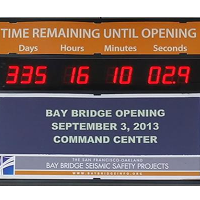Why Did Caltrans Use Previously Banned Bay Bridge Bolts that Are Breaking?

Three months ago Governor Jerry Brown was celebrating with California Department of Transportation (Caltrans) officials the beginning of the countdown to a September 3 opening of the new eastern span of the San Francisco-Oakland Bay Bridge.
Two months ago, 32 busted bolts on the $6.4 billion bridge triggered a review and generated some concern that some on-the-fly repairs might slow construction down a few weeks. A month ago, optimistic officials were pondering the cause of the problem, potential fixes and estimated costs.
By Monday, there was talk that 400 hard-to-access bolts in the bridge’s base and 1,900 elsewhere may be at risk, the Federal Highway Administration was investigating what went wrong, Governor Brown was hedging on the September 3 grand opening, and the San Francisco Chronicle had quoted one of the three experts on the peer-review panel that reviews Caltrans work openly asking what possessed the agency to use the bolts in the first place.
“I would have certainly urged them to take another course,” John Fisher, emeritus professor of civil engineering at Lehigh University, told the newspaper. “I'm not 100% sure why they looked at this the way they did.”
The bolts, which are actually special galvanized rods up to 24-feet long, were prohibited by Caltrans on bridges in 2000, according to the Chronicle, because of their vulnerability to hardening and cracking. The federal government has warned about using them for decades. But in 2002, Caltrans decided to use them anyway with “eyes wide open,” according to Caltrans Director Malcolm Dougherty.
The Bay Bridge is actually a pair of spans connecting San Francisco and Oakland that meet in the middle at Yerba Buena Island. The bolts that snapped connect steel earthquake safety shear keys to the deck of the eastern span and large concrete cap. They are not readily accessible, which will complicate any corrective action.
A former senior Caltrans corrosion engineer, Rob Reis, told the paper he had warned officials early and often that they should test the rods before installing them because of their potential to become brittle in a marine environment. Caltrans acknowledged that no tests were done, but couldn’t explain why.
“We are digging into that right now,” said chief Caltrans engineer Brian Maroney.
–Ken Broder
To Learn More:
Expert: Replace at-Risk Bay Bridge Rods (by Jaxon Van Derbeken, San Francisco Chronicle)
Feds to Probe Bay Bridge Problems (by Jaxon Van Derbeken, San Francisco Chronicle)
Bay Bridge Bolts: Problems with Iconic Span’s Construction Extend to Structure's Base (by Aaron Sankin, Huffington Post)
Engineers Around the World Anxiously Awaiting Results of Bay Bridge Bolt Failure Analysis (by Lisa Vorderbrueggen, Contra Costa Times)
Busted Bolts Delay $6.4-Billion Bay Bridge Upgrade (by Ken Broder, AllGov California)
- Top Stories
- Controversies
- Where is the Money Going?
- California and the Nation
- Appointments and Resignations
- Unusual News
- Latest News
- California Forbids U.S. Immigration Agents from Pretending to be Police
- California Lawmakers Urged to Strip “Self-Dealing” Tax Board of Its Duties
- Big Oil’s Grip on California
- Santa Cruz Police See Homeland Security Betrayal in Use of Gang Roundup as Cover for Immigration Raid
- Oil Companies Face Deadline to Stop Polluting California Groundwater





